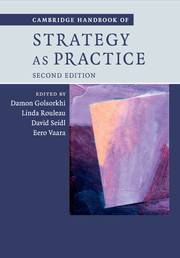Book contents
- Frontmatter
- Contents
- List of figures
- List of tables
- List of boxes
- List of contributors
- Preface to the Second Edition
- Introduction: what is strategy as practice?
- Part I Ontological and Epistemological Questions
- Part II Theoretical Resources: Social Theory
- Part III Theoretical Resources: Organization and Management Theories
- 16 An institutional perspective on strategy as practice
- 17 Relating strategy as practice to the resource-based view, capabilities perspectives and the micro-foundations approach
- 18 Theory of routine dynamics and connections to strategy as practice
- 19 Identity work as a strategic practice
- 20 Sensemaking in strategy as practice: a phenomenon or a perspective?
- 21 The communicative constitution of strategy-making: exploring fleeting moments of strategy
- 22 Analytical frames for studying power in strategy as practice and beyond
- 23 A critical perspective on strategy as practice
- Part IV Methodological Resources
- Part V Substantive Topic Areas
- Index
- References
16 - An institutional perspective on strategy as practice
from Part III - Theoretical Resources: Organization and Management Theories
Published online by Cambridge University Press: 05 October 2015
- Frontmatter
- Contents
- List of figures
- List of tables
- List of boxes
- List of contributors
- Preface to the Second Edition
- Introduction: what is strategy as practice?
- Part I Ontological and Epistemological Questions
- Part II Theoretical Resources: Social Theory
- Part III Theoretical Resources: Organization and Management Theories
- 16 An institutional perspective on strategy as practice
- 17 Relating strategy as practice to the resource-based view, capabilities perspectives and the micro-foundations approach
- 18 Theory of routine dynamics and connections to strategy as practice
- 19 Identity work as a strategic practice
- 20 Sensemaking in strategy as practice: a phenomenon or a perspective?
- 21 The communicative constitution of strategy-making: exploring fleeting moments of strategy
- 22 Analytical frames for studying power in strategy as practice and beyond
- 23 A critical perspective on strategy as practice
- Part IV Methodological Resources
- Part V Substantive Topic Areas
- Index
- References
Summary
Introduction
Institutional scholars have recently started to reach out to strategy-as-practice concepts to better conceptualize institutional landscapes and the ways in which organizations construct and navigate them in practice. Specifically, they seek to engage SAP scholarship in order to enhance their theorizing of institutional logics (Thornton, Ocasio and Lounsbury 2012), ‘institutional complexity’ (Greenwood et al. 2011) and ‘institutional work’ (Lawrence and Suddaby 2006) and their understanding of the ‘micro-foundations’ of institutions (Powell and Colyvas 2008). Simultaneously, strategy-as-practice scholars have begun to look beyond the intra-organizational activities that have traditionally preoccupied them and to work at their stronger contextualization in the broader social orders that have been the hallmark of institutional research (Vaara and Whittington 2012; Whittington, in this volume).
This rapprochement may appear unsurprising, given that both theoretical strands share common roots in the seminal works of Bourdieu (1977; 1990) and Giddens (1984). Much like siblings separated at birth, however, institutional and practice theories have gone on distinct journeys, characterized by different foci on the structure–agency spectrum and levels of analysis. While institutional scholarship through the 1990s often gave primacy to structure, stability and the macro-level contexts that condition organizations (DiMaggio and Powell 1983; Greenwood et al. 2008; Scott 1987), strategy-as-practice scholars have emphasized agency, potential for change and the collective activities of individuals inside organizations (Chia and Holt 2009; Jarzabkowski 2005; Jarzabkowski and Wolf, in this volume). This history makes the recent re-engagement noteworthy and means that, much like reunited siblings with different views of the world, they can open each other's eyes to new phenomena and start looking at familiar phenomena in new ways.
The metaphorical notion of estrangement, reunion and mutual enrichment drives the structure of this chapter. In the second section we briefly trace the evolution of institutional theory to understand where and why it lost touch with practice theory and which issues have recently motivated it to reach out for re-engagement. The third section then outlines shared concerns and concepts over which institutional and strategy-as-practice scholars can connect and strike up fruitful conversations. The fourth section sketches the nascent insights that have recently emerged from some of those conversations. Finally, the conclusion summarizes the mutual benefits to be gained from blending institutional and SAP scholarship and outlines yet under-explored areas as avenues for future research.
- Type
- Chapter
- Information
- Cambridge Handbook of Strategy as Practice , pp. 283 - 300Publisher: Cambridge University PressPrint publication year: 2015
References
- 26
- Cited by



